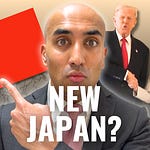What is covered in today’s insight?
How is the West going after China (and why)
The Chinese options to retaliate
Consequences for Western businesses
INTRODUCTION
When UBS, the Swiss bank, forecasted that China’s economic growth would be halved if Trump returned to the White House and imposed a 60% flat tax on all Chinese imports, more than likely Beijing gasped.
The idea of China’s economy being derailed like that is unthinkable for the Chinese government, which has been in charge of its growth and development for decades.
However, possible futures aside, what has occurred in the last few months between the West and China, is just as significant for China’s economy and its place and position in the world.
Unfortunately, between other world events, from Ukraine to Israel, the gravity of what has been signed into law or is about to enter law in the West has been lost. But make no mistake: the direction Western capitals are moving in represents a new strategy to stop China’s momentum in new fronts, like green exports, which are becoming critical to Beijing’s ability to rewire the world.
In 2023 alone, China exported over $35 billion worth of EVs, a headshaking 12,334% jump from 2018, when China exported just $295 million worth of EVs!
In May, the US announced it would raise the tariffs on Chinese EV imports from 25% to 100%, citing China’s overcapacity and the rapid growth of Chinese EVs in the global market. Between 2022 and 2023, Chinese global EV exports increased 70%. In 2023 alone, China exported over $35 billion worth of EVs, a headshaking 12,334% jump from 2018, when China exported just $295 million worth of EVs!
The US also announced it would raise the levy on Chinese chip imports from 25% to 50% (starting in 2025) whilst also hitting Chinese solar cells (with a 50% tariff) and Chinese EV batteries, aluminum, steel, and critical minerals (with a 25% tariff).
In June, the EU unveiled a second layer of tariffs on Chinese EVs. On September 25, Brussels will hold a vote on the levies, and if approved, will raise duties on some EV imports to almost 50%. A slight exception was given to Tesla, which exports cars to Europe from China. At a time when Europe wants to give its companies an edge, it is strange that Brussels gave its only “hall pass” to an American car company, not a European one.
On the heels of the US and European tariffs, in August, Canada unveiled its own measures, mimicking the US with a 100% tariff on Chinese EV imports and a 25% tariff on Chinese steel and aluminum imports. It comes at the outset of a major political scandal in Canada, where a Liberal member of parliament (MP), Han Dong, part of Prime Minister Justin Trudeau’s governing party, resigned after being accused of abetting Chinese foreign interference. The scandal was particularly serious, considering Dong was accused of telling the Chinese consul-general in Toronto to push back the release of two Canadian nationals imprisoned in China, an accusation that Dong denies. The entire saga prompted Ottawa to investigate foreign interference, where one of the reports commissioned labeled China as the “main perpetrator.”
The moves by Washington, Brussels, and Ottawa, separated by just weeks, represent a new Western economic front against China, in particular China’s green economy. It is the beginning of a new strategy, by the bulk of the West, to ensure China does not control key battlefields of tomorrow.
Add in the various other China-centric challenges, like foreign interference in Canada or growing hostility between the US and China, including around the Philippines, and the fight between the West and China has entered a dangerous new chapter.
Any idea that the West and China could return to stability is now a pipe dream.
WESTERN STRATEGY
The West’s tariffs, in particular from the US, represent a new phase of an old strategy to take on China.
To start with, the West is putting China’s green exports in the bullseye.
This is different from focusing on steel dumping or IP theft. The rapid and massive rise of China’s green sectors, from batteries to EVs, is jolting Western capitals. What China has built, coupled with what’s being dubbed “overcapacity,” where China is able to mass-produce and mass-export goods in a way that jeopardizes local economies, gives Beijing new geoeconomic control over the world.
From Asia to Africa, emerging markets could be dominated by Chinese EVs or solar panels, and the ecosystems behind them, just as these markets are currently dominated by Chinese consumer technologies (i.e. cheap handsets) or Chinese infrastructure (i.e. roads, highways).
For example, no Chinese EVs are currently sold in the US or Canada, largely because tariffs turn pricing upside down.
This is something the West can’t afford.
To stop this, the West is heeding lessons from previous waves Chinese expansion.
Unlike Huawei’s 5G or TikTok, which were already “deep” in Western society before governments took action, the West is taking steps before some of China’s green exports dominate.
For example, no Chinese EVs are currently sold in the US or Canada, largely because tariffs turn pricing upside down. Meanwhile, in Europe, Chinese EVs have achieved 11% marketshare, a “manageable” level of competition for non-Chinese automakers in the region.
However, this is not black and white.
While the West might be ahead on some fronts, like blocking Chinese EVs before the cheap vehicles flood and overwhelm local brands, on other fronts the West is way behind.
For example, another critical green export, solar panels, is dominated by Beijing, where China controls 80% of global solar panel supply chains. And, next year, Chinese firms will produce enough solar panels in America itself to supply almost 50% of the US market.
For US politicians who want to restart American manufacturing or keep China at shore, this is an uncomfortable reality. In a major industry of tomorrow, China is not only winning, China is dominating in America itself.
Watching China’s domination of solar, a key new energy corridor is forcing Western capitals to get serious about other Chinese green exports.
Alongside this is a separate strategy with the tariffs, which is to establish a new “Pax Americana” so to speak, where the Western hemisphere has a limited Chinese footprint.
As the US mulls big steps to stem Chinese EV production in Mexico, along with the Mexican government halting subsidies to Chinese EV companies, all of North America has an increasingly united front against green Chinese auto exports. Add in the EU, and the transatlantic world, representing the majority of the collective West, is standing on common ground in this respect.
And, as Washington, Ottawa, and Brussels establish new trade barriers against China, it will prod many others in the hemisphere, especially South America, to rethink their alignment with China.
It is a clear message that accepting Chinese investment in green sectors will come under fire.
And, this message will be sent beyond the Western hemisphere as America brings other allies onto the same page.
Other events are unfolding that signal a dramatic shift in the thinking of US allies who once stayed neutral to keep China happy, like South Korea offering the Philippines fighter jets as Manila clashes with Beijing or Japan unveiling plans to have the third-largest defense budget in the world as China’s military creates new security fears in Tokyo.
All of these steps make it clear to Washington, who in its orbit may be receptive to joining the new “three musketeers” (US, Canada, EU), in clamping down on China in the green space.
And, for everybody else, it will increasingly become clear that remaining open to China’s green economy is as significant a move as ditching the dollar in trade or supporting China’s claims in the South China Sea. It puts nations in a diametrically opposite court to the West.
Who is willing to do that?
CHINA’S RESPONSE
Unlike when the West went after Chinese technology, Beijing won’t sit quietly now.
Just as in the case of Serbia, where China was quietly and strategically investing in the Eastern European country as relations with the West soured during the pandemic, so too, Beijing is taking a range of steps to offset what Western capitals are doing.
What if America doesn’t allow Chinese batteries in its EVs? Or in any EVs America imports?
The biggest is to build in the West itself.
For example, the BYD and CATL factories in Hungary. Or, separately, China’s EV plants in Southeast Asia like Vietnam or parts of Africa like Morocco. This is “geopolitical innovation,” where China is circumventing the West trade strategy which heavily focuses on “imports.” By building within the West itself, from EVs in Hungary to solar panels in the US, China is not importing final products. And, by manufacturing within Western economies, China controls a separate lever: thousands upon thousands of jobs.
If Western governments seek to go after China’s manufacturing footprint within Western economies, they will jeopardize a massive job base, meaning economic stability and votes.
However, as the West unites, putting China under an economic siege, these projects could be jeopardized in other ways. What if America doesn’t allow Chinese batteries in its EVs? Or in any EVs America imports?
China can’t bet on these projects to shield it from what’s on the horizon. China has to retaliate, not just change its footprint. There are three key ways Beijing could move against the new Western geoeconomics.
First, China could either sit back and smile. One analysis has found that some Chinese EVs will still be cheaper than their Western counterparts even after tariffs are applied, for example, the BYD Seagull, which costs just $10,000 (before the 100% duties). Even at $20,000, the Seagull still comes in cheaper than all EVs from Western automakers. Ford’s CEO, Jim Farley, even mentioned the BYD Seagull by name in a call, as he sounded the alarm on EV competition in China.
For now, China has to do nothing. But, if the West raises the tariffs again in the future, a highly likely move, Beijing could unveil more state subsidies, artificially lowering its EV prices in a bid to undercut Western tariffs. This would also put new pressure on Western policymakers to back away from tariffs as they are not having the intended effect, creating a new source of friction between Western politicians and businesses, the latter of whom wants levies removed.
Second, alongside new state subsidies, Beijing could attempt to make an example out of a Western country. In this current setup, the likely candidate is Canada, considering Canada’s GDP is just north of $2.1 trillion, considerably less than the EU ($18 trillion) or the US ($25 trillion).
What China decides towards Canada, from pausing foreign investment to selling off Canadian assets to ejecting Canadian firms from the Chinese market, would also be messages to everybody else that Beijing is not to be crossed. Just as the Chinese moves against Lithuania jolted many in Europe, even forcing Brussels to create the “Anti-Coercion Instrument (ACI)", the Chinese retaliation against Canada would have the same optical effect.
Third, and lastly, China could accelerate its focus on emerging markets, especially parts of Asia and Africa. Through new financing deals between China and local governments, China could offer its EVs at a hugely discounted rate, completely overwhelming Western automakers. And, connected to this, China could start using its geoeconomic footprint against other nations. From Africa to South America, nations that are in debt to China could be forced into new agreements, like giving Chinese companies exclusive access.
And, all of these potential moves, are alongside China’s expected and continuing tit-for-tat trade action on Western exports.
GLOBAL CONSEQUENCES
As the West goes after China’s green economy, and in the process, chokes China’s economic ambitions, and as China retaliates, shockwaves will be generated that the world has to deal with.
The world of business has to prepare for an onslaught.
For many companies, becoming “China free” has to be part of the corporate strategy, as crazy or unimaginable as this may sound.
In particular, Western companies need to begin redesigning their entire footprint in China. The time and space for change is quickly contracting. Building in China and then importing into the West is no longer an option. And, the “quick fixes” like importing from China, assembling in a third-party nation (including with Chinese companies), and then exporting to the West, are likely already in the crosshairs behind closed doors. Even the Chinese appeasement, like Chinese automakers telling Brussels they will commit to a minimum import price, has been flatly rejected.
The West does not want certain Chinese goods within their borders in any form.
For many companies, becoming “China-free” has to be part of the corporate strategy, as crazy or unimaginable as this may sound. And what this looks like, clearly grey, will require tremendous corporate resources and innovation.
Separately, in the West, different industries could collide over China.
Not only is friction emerging between the state and businesses, as Western firms do not want the government to take new actions against China, but now too, Western sectors could be colliding with one another.
The British government is mysteriously quiet as Brussels and Washington take new actions towards Beijing. This is compared to how London was behaving just a short time ago, from screening Chinese FDI to phasing out Huawei’s 5G technology to signing AUKUS to boost the West’s footprint in the Indo-Pacific.
The actions that Washington, Ottawa, and Brussels have taken to protect their auto industries from Chinese EVs, could result in Western tech or finance sectors being hit by China’s retaliation. These sectors and their companies might not want to be in the crossfire or be part of the equation. Except, to protect the auto industry that is exactly what is on the table. Does JP Morgan support US steps to protect GM or Chrysler, if those same steps will cause JP Morgan to lose out in China?
A new fight between industries is looming as the West takes new aggressive steps against China’s green economy. What starts as a narrow fight between the West and China’s green exports, could quickly snowball into a holistic economic fight, or even an economic war.
Separately, on the world stage, the West has to figure out what to do with certain “holdouts,” namely Germany, the UK, and Australia.
The British government is mysteriously quiet as Brussels and Washington take new actions towards Beijing. This is compared to how London was behaving just a short time ago, from screening Chinese FDI to phasing out Huawei’s 5G technology to signing AUKUS to boost the West’s footprint in the Indo-Pacific. But, when it comes to EV tariffs, the new British trade minister has categorically said, he is not planning to introduce similar measures to Brussels or Washington.
The continued movement towards Beijing, by German companies, enabled by the German government, will slow down the EU’s strategy and cause others in the union to continue standing on board the Chinese train. This has been a problem for some time. But, with the focus on Chinese green autos, there is no bigger automotive player than the likes of Germany. What German firms are doing, like Volkswagen who plans to unveil 30 new EVs or hybrid models just in China by 2030, could give China new ways to escape the “green moves” Washington, Ottawa, and Brussels are making.
Lastly, Australia has come full circle, going from romancing China before the pandemic to divorcing China after the pandemic, to dancing with China again. Last year, Australia exported a record amount to China, over $150 billion worth of goods, as trade relations between Canberra and Beijing stabilized. And while Australia has taken certain actions against China that reflect the distraught nature of the relationship, like forcing an Australian rare earths company to divest certain Chinese-linked stakeholders, Australia-China ties as a whole are in far better shape than they have been in a long time.
The US, backed by Canada and the EU, has to figure out how to bring other Western parties on board quickly.
And at the same time, how to ensure China doesn’t reach these capitals with allure and seduction before they are convinced to join a new Washington, Ottawa, Brussels foundation.
And if these governments don’t align, then the US, Canada, and EU might have to go in a separate direction, meaning the new economic siege on China could end up fragmenting the West.
Conclusion
For many, the US tariffs seem like nothing major. After all, over the past several years, tariffs have become a normal part of the US-China economic relationship. But, tariffs cannot be viewed in isolation. Because the parties designing them, from Washington to Brussels, are looking at a very big picture, from which they are unleashing levies and duties.
A core part of this big picture is that China’s green economy is no longer just a domestic phenomenon or a purely sustainable economic pillar. There are clear and serious geopolitical and geoeconomic overlaps to what China is doing with many of its green exports.
The tariffs are a step to thwart China’s rise in these areas. They won’t be the last step. And, they may not work at all.
Time will tell.
What is clear is that what begins as a fight over China’s green solutions, or sustainability, is not likely to remain there. The Chinese are not going to just hit back at Tesla, if the West hits BYD. For the West, the focus is on China’s green footprint, but building up to this, the West has gone after chips, steel, and AI, among other areas.
From this position, for China, the entire Western economy is fair game.
And, considering the enormous steps China is taking to invest in other nations, increasingly along green corridors, what is forming between the West and China could draw in the whole world.
What the West is doing has to be looked at through the lens of geoeconomics.
For China, the new Western moves cut oxygen, as without Western markets, the entire business strategy of Chinese green corporates could be derailed. Or, perhaps, China has factored this in from the get-go.
While many are worried about what is in store for January, 2025, between the US and China, Washington and Beijing are already in the boxing ring. The yelling for big brash action is growing louder. Allies of America, once in China’s embrace, are screaming for Washington.
The US has just swung. What will China do?
-Abishur
MR. GEOPOLITICS INSIGHTS:
WEST VS. CHINA
To get the full picture of the geopolitics playing out between the West and China, read the following insights from Mr. Geopolitics:
Want to republish this insight? Let’s talk: abishur@mrgeopolitics.com
If you liked this insight, why not invite your team?
Think somebody should read Mr. Geopolitics?











